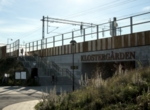Gunnesbo Station
1986 establishments in Sweden20th-century establishments in Skåne CountyBuildings and structures completed in 1986Buildings and structures in LundRailway stations in Lund ... and 4 more
Railway stations in Sweden opened in the 1980sRailway stations on the West Coast Line (Sweden)Railway stations opened in 1986Swedish railway station stubs

Gunnesbo Station is a commuter train railway station in the Gunnesbo district of Lund in Sweden. The station was inaugurated on 1June 1986 in order to serve commuters in the newly built districts Nöbbelöv and Gunnesbo along the West Coast Line. The local trains (Pågatåg) serve the station. The station was expanded in 2003–2005 for the double track that now runs through Lund along the West Coast Line.
Excerpt from the Wikipedia article Gunnesbo Station (License: CC BY-SA 3.0, Authors, Images).Gunnesbo Station
Jaktmarksgatan, Lund Municipality
Geographical coordinates (GPS) Address External links Nearby Places Show on map
Geographical coordinates (GPS)
| Latitude | Longitude |
|---|---|
| N 55.726944444444 ° | E 13.1675 ° |
Address
Gunnesbo
Jaktmarksgatan
226 55 Lund Municipality (Norr)
Sweden
Open on Google Maps










